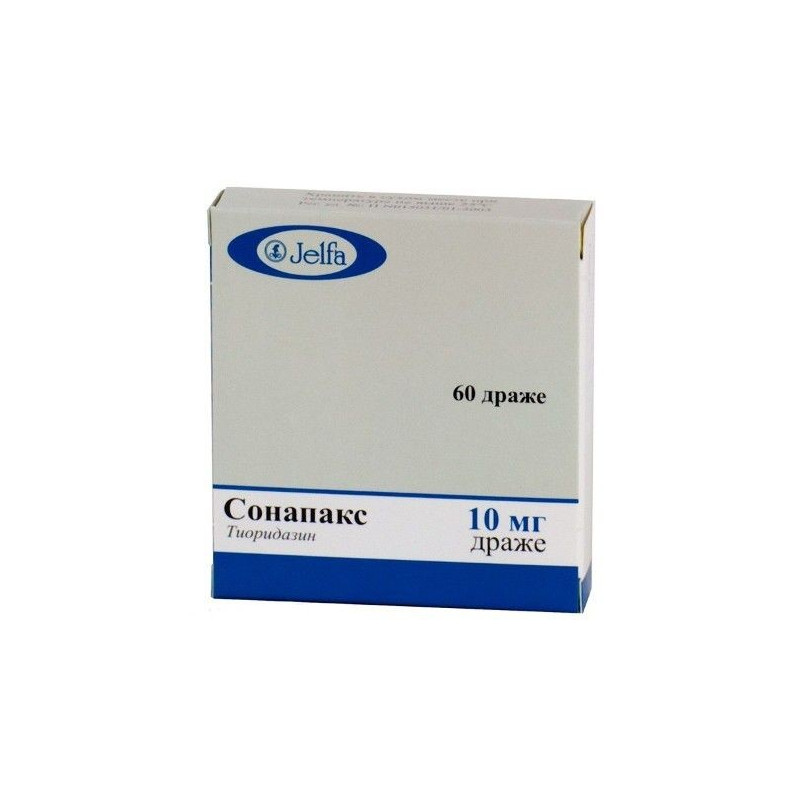



 All payments are encrypted via SSL
All payments are encrypted via SSL
 Full Refund if you haven't received your order
Full Refund if you haven't received your order
Active substance: thioridazine hydrochloride
Excipients: potato starch, sugar, gelatin, Magnesium stearate, talc, gum arabic, quinoline yellow dye.
60 pieces
Sonapax - thioridazine is a piperidine derivative of phenothiazine, which affects the central and peripheral nervous system.
It has antipsychotic, tranquilizing, antidepressant, antipruritic and antiemetic effects.
The mechanism of antipsychotic action is associated with the blockade of postsynaptic dopaminergic receptors in the mesolimbic structures of the brain.
The central antiemetic effect is due to the inhibition or blockade of dopamine D 2 receptors in the chemoreceptor trigger zone of the cerebellum, and the peripheral blockade of the vagus nerve in the gastrointestinal tract.
It also has a sympatolytic and m-anticholinergic action.
In small doses, it has an anxiolytic effect, reduces the feeling of tension and anxiety, in higher doses, it exhibits antipsychotic (neuroleptic) properties.
Antihistamine and anticholinergic action is most pronounced among all drugs from the group of antipsychotics.
In moderate therapeutic doses, it does not cause extrapyramidal disorders and drowsiness.
It has an alpha-adrenergic blocking effect and suppresses the release of pituitary and hypothalamic hormones.
However, the blockade of dopamine receptors increases the secretion of prolactin by the pituitary gland.
Schizophrenia.
Affective insanity.
Neurosis, accompanied by:
By fear.
Anxiety.
Excitement.
Voltage.
Depressed mood.
Sleep disturbance
Obsessive states.
Psychotic disorders accompanied by hyperreactivity and arousal.
Severe behavioral disorders associated with psychotic disorders or neurological diseases, accompanied by:
Aggressiveness.
Inability to prolonged concentration.
Abstinence syndrome (substance abuse, alcoholism).
Psychomotor excitation of various genesis.
Moderate and severe depression in adults.
Huntington's disease, tiki.
Skin diseases occurring with severe and painful itching.
In child psychiatry, it is used for behavioral disorders with increased psychomotor activity.
Hypersensitivity.
Acute depressive states.
Coma of any etiology.
Traumatic brain injury.
Progressive systemic diseases of the brain and spinal cord.
Severe cardiovascular failure.
Severe arterial hypotension.
Pheochromocytoma.
Porphyria.
Blood diseases (hypo-and aplastic processes).
Pregnancy.
Lactation period.
Children age up to 4 years.
Contraindicated use during pregnancy and breastfeeding.
Synergism of action with general anesthetics, opiates, barbiturates, ethanol, atropine.
Enhances the hepatotoxic effect of antidiabetic drugs.
With amphetamine - acts antagonistically. With levodopa - reduces anti-parkinsonian action.
Use with adrenaline - can lead to a sudden and pronounced decrease in blood pressure.
With guanethidine reduces the antihypertensive effect of the latter, but enhances the effect of other antihypertensive drugs, which increases the risk of significant orthostatic hypotension.
Reduces the effect of anti coagulants. The action of Sonapax can weaken anticonvulsant drugs, cimetidine.
Quinidine - potentiates the cardiodepressive effect.
Ephedrine - contributes to a paradoxical decrease in blood pressure. Sympathomimetics - increase the arrhythmogenic effect.
Probucol, astemizol, cisapride, disopyramide, Erythromycin, pimozide, procainamide and quinidine contribute to further lengthening the QT interval, which increases the risk of ventricular tachycardia.
Antithyroid drugs increase the risk of agranulocytosis.
Reduces the effect of appetite suppressants (with the exception of fenfluramine).
Reduces the efficacy of apomorphine emetic, enhances its inhibitory effect on the central nervous system.
Increases plasma concentration of prolactin and interferes with the action of Bromocriptine.
When used together with tricyclic antidepressants, maprotiline, MAO inhibitors, antihistamines, prolongation and enhancement of sedative and anticholinergic effects is possible.
With thiazide diuretics - increased hyponatremia.
With lithium preparations - a decrease in absorption in the gastrointestinal tract, an increase in the rate of lithium ion excretion by the kidneys, increased severity of extrapyramidal disorders, early signs of lithium toxicity (nausea and vomiting) can be masked by the antiemetic effect of perfenazine.
When combined with beta-adrenergic blockers, it enhances the hypotensive effect, increases the risk of developing irreversible retinopathy, arrhythmias and tardive dyskinesia.
Store in a dry place at a temperature not exceeding 25 ° C.
